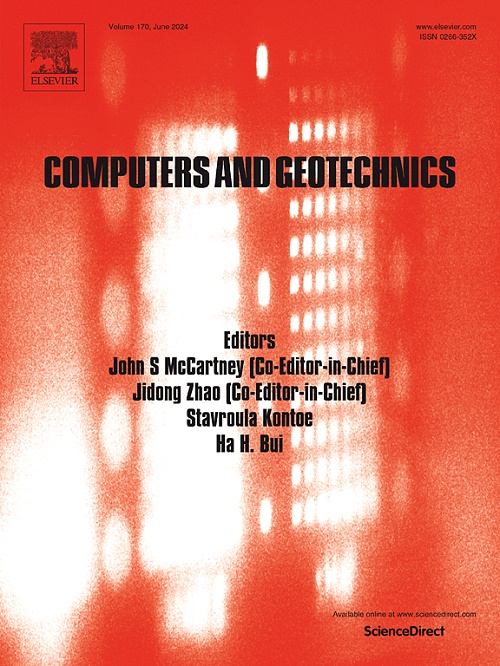SPH modeling of impact forces from heterogeneous soil-rock mixture landslides on a rigid obstruction
IF 5.3
1区 工程技术
Q1 COMPUTER SCIENCE, INTERDISCIPLINARY APPLICATIONS
引用次数: 0
Abstract
Soil-rock mixture landslides frequently occur in steep mountainous regions, indicating enormous destructive potential. Consequently, these landslides have attracted much attention from researchers in recent years. This paper presents a simple and effective meshless numerical method based on Smoothed Particle Hydrodynamics (SPH) to simulate the movement and impact forces of heterogeneous soil-rock mixture landslides. In this method, soil and rock are discretized as SPH particles with different material properties and are modeled as elastoplastic and elastic materials, respectively. The ideal elastoplastic model with a nonassociated flow rule, combined with the Drucker-Prager (DP) yield criterion, is employed to describe the constitutive response. First, the paper validates the soil pressure exerted on the bottom wall of a stationary container. Second, the impact experiment of a single rock sample is verified, and the effects of the rock density, shape, and drop height are further analyzed. Last, the proposed method is employed to simulate and validate the movement and impact force of homogeneous soil landslides, followed by heterogeneous landslides. The results indicate that the proposed method is feasible for simulating the movement and impact forces of heterogeneous soil-rock mixture landslides. Additionally, this method is simple to implement, highly flexible, and capable of accommodating arbitrarily-shaped rocks. The presence of rocks alters the characteristics of the impact force and partly increases the peak impact force, particularly in steep slope scenarios. These findings enhance our understanding of the complex phenomena associated with heterogeneous landslides, including debris flows that involve multiple phases and scales, and offer significant guidance for disaster prevention and mitigation in geological engineering.
非均质土石混合体滑坡对刚性障碍物冲击力的SPH模拟
土石混合滑坡多发于陡峭山区,具有巨大的破坏潜力。因此,近年来这些滑坡引起了研究人员的广泛关注。本文提出了一种简单有效的基于光滑颗粒流体力学(SPH)的无网格数值模拟方法,用于模拟非均质土石混合体滑坡的运动和冲击力。该方法将土壤和岩石离散为具有不同材料性质的SPH颗粒,并分别建模为弹塑性和弹性材料。采用具有非关联流动规则的理想弹塑性模型,结合Drucker-Prager (DP)屈服准则来描述本构响应。首先,对固定容器底壁土压力进行了验证。其次,对单个岩样的冲击试验进行了验证,并进一步分析了岩石密度、形状和落点高度的影响。最后,采用该方法对均质土质滑坡的运动和冲击力进行了模拟验证,然后对非均质土质滑坡进行了模拟验证。结果表明,该方法对模拟非均质土石混合体滑坡的运动和冲击力是可行的。此外,这种方法实施简单,灵活性高,能够适应任意形状的岩石。岩石的存在改变了冲击力的特征,并在一定程度上增加了峰值冲击力,特别是在陡坡情况下。这些发现有助于我们进一步认识包括泥石流在内的多阶段、多尺度非均质滑坡的复杂现象,对地质工程防灾减灾具有重要指导意义。
本文章由计算机程序翻译,如有差异,请以英文原文为准。
求助全文
约1分钟内获得全文
求助全文
来源期刊

Computers and Geotechnics
地学-地球科学综合
CiteScore
9.10
自引率
15.10%
发文量
438
审稿时长
45 days
期刊介绍:
The use of computers is firmly established in geotechnical engineering and continues to grow rapidly in both engineering practice and academe. The development of advanced numerical techniques and constitutive modeling, in conjunction with rapid developments in computer hardware, enables problems to be tackled that were unthinkable even a few years ago. Computers and Geotechnics provides an up-to-date reference for engineers and researchers engaged in computer aided analysis and research in geotechnical engineering. The journal is intended for an expeditious dissemination of advanced computer applications across a broad range of geotechnical topics. Contributions on advances in numerical algorithms, computer implementation of new constitutive models and probabilistic methods are especially encouraged.
 求助内容:
求助内容: 应助结果提醒方式:
应助结果提醒方式:


